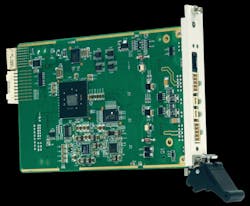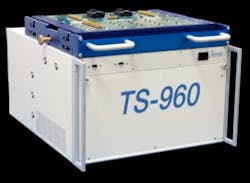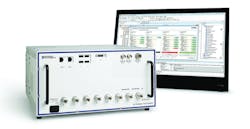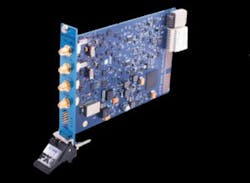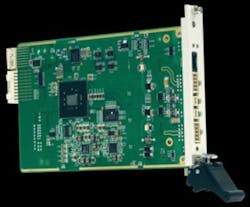To better understand PXI today, it helps to review its advantages as well as the alternatives. An article on the EE-Evaluation Engineering website analyzed approximately 2,000 LXI-compliant products.1 The majority of them were power supplies—LXI does not have PXI’s 30-W limitation per 3U slot. And there’s also no size restriction on LXI products, so it’s a good choice for large power supplies. In addition, slower Ethernet speeds are fine. Power-supply programming doesn’t need gigahertz bandwidth.
For many applications, VXI and PXI have the necessary variety of module types, but few manufacturers still support VXI, and even fewer are developing new modules in that large format. AXIe and USB both lack the range of module types found in VXI and PXI. USB is not limited to standalone instruments, but neither are USB-based test systems common. AXIe-1 is large and expensive, and AXIe-0, although less expensive, is too new to have become popular. So, if you need to build a test system with a range of instrument types, a small footprint, relatively low power, and high bandwidth, PXI is the logical choice.
This conclusion isn’t new, but PXI’s attributes have become more relevant as a number of applications have matured. 5G channel sounding is one of several research areas demanding a large number of high-bandwidth instrument channels. Keysight Technologies’ 5G Channel Sounding reference solution incorporates a selection of the company’s products including multiples of the M9362A-D01 PXIe quad downconverter and the M9352A PXI hybrid amplifier/attenuator. In another communications application, National Instruments (NI) and Lund University in Sweden collaborated to develop a massive MIMO system capable of handling 100 antennas. The implementation includes 50 universal software radio peripheral RIO software-defined radios.
Semiconductor test is an additional area in which a large number of channels often are needed. Last year, NI released three versions of the Semiconductor Test System (STS) with one, two, or four 18-slot PXI chassis, system cabling, a spring probe interface, a standard device interface board infrastructure, and system utilities including monitoring and calibration. Of particular interest for RF device test, port expansion modules support multiport RF test. With one or more vector signal transceivers, the STS can provide up to 48 bidirectional RF ports.
Courtesy of Marvin Test Solutions
Marvin Test Solutions (MTS) also has developed a semiconductor test system, the TS-900 (Figure 1) with a 20-slot 3U PXI chassis. As explained by Mike Dewey, director of marketing at the company, “The TS-960 offers an advanced digital subsystem—the GX5296 which supports timing per-pin, data formatting, and PMU per-pin capability, essentially providing features that have only been found in proprietary ‘big iron’ ATE. With timing per-pin flexibility and 1-ns edge placement per pin, the TS-960 accommodates users performing AC characterization on digital and mixed-signal devices as well as allowing users to take advantage of PXI’s open architecture. Additionally,” he concluded, “with the digital instrument having 32 channels per single PXI slot, a TS-960 can support up to 512 high-performance digital I/O channels within a single mainframe chassis.”
Standard Platforms
In the past, many test instrumentation companies have built custom systems for clients. The difference today is that platforms are being developed as standard products that require either minimal or zero additional integration by the customer. NI’s STS was followed this year by the Wireless Test System (WTS), introduced at NIWeek 2015 and shown in Figure 2. As with the STS, the WTS includes sufficiently comprehensive and varied hardware and software that the platform, according to the NI WTS brochure, “integrates easily into a manufacturing line using ready-to-run reference test sequences, integrated DUT control, and remote automation control.”
The ready-to-run test sequences handle several popular protocols: Wi-Fi 802.11a/b/g/n/ac, Bluetooth and Bluetooth LE, GPS, FM/RDS, and LTE-A/LTE/HSPA+/WCDMA/TD-SCDMA/CDMA2000/EDGE/GSM. Bandwidths up to 200 MHz and carrier frequencies from 65 MHz to 6 GHz are supported.
The MTS TS-900 is available as a benchtop unit with an integrated cart or an integrated manipulator. The basic system has 64 100-MHz digital I/O and 64 static digital channels, a programmable 0- to 48-V power supply, and a system self-test and fixture. Software includes DIOEasy for digital waveform editing, ICEasy device test development tools, and ATEasy—an integrated test executive and test development environment. Fourteen open chassis slots remain so the user can customize the solution to particular applications. The TS-906 version features a 6U PXI chassis and the GX5960 digital subsystem with -15-V to 25-V drive and sense levels.
Keysight has introduced five reference solutions that greatly reduce the amount of effort required to create the exact solution you need. They address satellite signal monitoring, next-generation power amplifier modules, LTE/LTE-A multichannel systems, multichannel antenna calibration, and 5G channel sounding. As described on the company’s website, reference solutions “enable quick evaluation of the test solution’s performance and capability for a specific application, reduce the time it takes to integrate a new test system into a test environment, and leverage Keysight’s measurement expertise and software for specific application requirements.”
The degree to which platforms provide a complete solution is the major distinction among them. For example, NI’s WTS is expressly aimed at manufacturing test. It contains a PXIe chassis, modules, and associated software, but within a robust production-floor housing. Something seemingly as simple as the need to repeatedly connect/disconnect multiple DUTs requires special consideration because most connectors are not rated for thousands of insertions/withdrawals. Of course, this usually isn’t a limitation in design or research applications.
High functionality modules
Another important trend has been to increase performance at the module level. AIM’s PXIe ACE1553-3U-x single-, dual-, or quad-stream MIL-STD-1553A/B test and simulation modules are good examples. Bill Wargo, president of AIM-USA, explained, “The product features AIM’s advanced Common Core Architecture to provide a powerful test and simulation tool for the most demanding applications. It can function as a bus controller, 31 remote terminals, and a bus monitor on up to four dual-redundant MIL-STD-1553 buses.” He continued, “A unique feature of AIM’s ACE1553 module is the option for the MILScope capability. Models ACE1553-3U-1/2-DS integrate an onboard ADC which samples, measures, and stores the MIL-STD-1553 waveform. Automatic waveform validation is performed by the user’s application software or in conjunction with AIM’s PBA.pro Databus test and analysis software.” He concluded, “By utilizing the ACE1553 module with the MILScope capability in conjunction with PBA.pro and scripts that perform the SAE tests, AIM has enabled multiple customers to fully automate both the design validation and production testing with an off-the-shelf solution while requiring no external test equipment.”
GuideTech has been active in the precision time and frequency measurement business for a number of years. Ron Sigura, CEO and chairman of the company, commented on several recently introduced PXI/PXIe products—the GT668 continuous time interval analyzer (CTIA)/event timer (Figure 3), the GT210 universal frequency counter, and the GT916MUX 17-to-2 active multiplexer. Specifically, he said that the new GT668 CTIA/event-timer featured up to 4M measurements/s with zero dead time. Available with time resolution from 0.9 ps to 40 ps, the GT668 supports measurement of PLL and clock jitter, spread spectrum modulation, PLL lock time, frequency to 12 digits, period, pulse width, skew, and rise/fall time. Up to 34 channels can be housed in one PXIe chassis. Software includes drivers for Java and Python, Windows versions through Windows 8, Linux, and NI LabVIEW.
The GT210 time interval counter can determine any frequency from DC to 2.7 GHz to eight digits of precision in 1 ms and to 11 digits in 1 s. In addition, the GT210 provides built-in statistics to compute standard deviation and peak-to-peak jitter. Dual matched input channels measure time interval, frequency, period, totalize, ratio, and pulse width. Finally, the GT916MUX with 6-GHz bandwidth switches either 16 single-ended or eight differential signals to one of two outputs. A reference 17th signal can be routed to either or both outputs for skew or propagation delay measurements.
NI’s 26.5-GHz PXIe-5668R VSA and spectrum analyzer covers a 20-Hz to 26.5-GHz frequency range. The multimodule product comprises the PXIe-5624R 2-GS/s IF digitizer, the PXIe-5606 20-Hz to 26.5-GHz downconverter, and the PXIe-5653 synthesizer. Several lower frequency models also are available: PXIe-5661 from 9 kHz to 2.7 GHz, the PXIe 5663 from 10 MHz to 6.6 GHz, and the PXIe-5665 from 20 Hz to 3.6 or 14 GHz.
David Hall, the company’s principal product manager-RF test, said the PXIe-5668R VSA was “… the latest in a line of NI modular instruments featuring user-programmable FPGAs programmed with LabVIEW. In addition to its software features, one of the key differentiators of the new VSA is that it offers up to 765 MHz of instantaneous bandwidth. The extremely wide bandwidth is made possible through a combination of new analog-to-digital-converter and signal-processing technologies. In fact, one of NI’s key innovations on the PXIe-5668R is the intense signal processing onboard the instrument.”
Hall continued, “The NI PXIe-5668R is ideal for signal intelligence and spectrum monitoring applications given its combination of high dynamic range, wide bandwidth, and highly customizable signal-processing capabilities. Engineers’ ability to program the instrument’s onboard FPGA with LabVIEW allows them to process signals in real time. Additionally, from data reduction algorithms such as channelized digital downconverters to blind detection algorithms, engineers can more effectively analyze and process over-the-air transmissions with the new module.”
Although PXI/PXIe power supplies aren’t common, a few special-purpose modules are available. The 52400 Series SMUs (Figure 4) from the Integrated System Solutions business unit at Chroma ATE are four-quadrant units particularly well-suited to semiconductor, LED, solar, and sensor testing. Jeff Lee, a director at the company, said that input from Chroma’s semiconductor testing sector helped to define the products. He said, “Chroma also has diverse experience in LED, laser diode, and photo diode testing. Detailed knowledge of the application requirements helps us to improve our SMUs to have higher performance and provide a multipurpose solution.”
Figure 4. 52400 Series SMU
Courtesy of Chroma ATE
The Model 52401-25-200m has two 5-W outputs with ±25-V and ±200-mA limits. It operates from the PXI/PXIe chassis power supply. Models 52405-5-3, -10-2, -25-1, and -25-3 each have two channels with 25-W output capability and use an external 48-V DC supply. Features for all models include 16 selectable control bandwidths to ensure stable operation for many load types, 18-bit DAC/ADC for high resolution, a 100-kS/s sampling rate, programmable output resistance for battery simulation, and guard lines to avoid leakage current.
Lee explained that, “We recently received an order for 30 of our model 52405 units from a laser diode customer. The key winning factor was the SMU’s lack of overshoot or undershoot when slewing at high speed. Laser diodes are known to be sensitive to overshoot and undershoot, which can potentially damage the parts. The traditional solution is to slow down the output transitions, but this also will slow down the test. The Chroma 52405 provides a noncompromising solution that helps the customer increase test throughput.”
Conduant’s latest mass storage modules are yet additional examples of adopting computer industry solutions to test and measurement applications. The PXI/PXIe single-slot DM-M.2-3U storage unit provides up to 2 terabytes of solid-state storage using up to four M.2 solid-state drives (SSDs).
What is an M.2 SSD? According to Zsolt Kerekes, editor at www.storagesearch.com, M.2 SSDs were introduced in 2012 and rapidly gained attention because they provide better volumetric packing density than smaller SSDs and support both PCIe and SATA interfaces. SATA SSDs have a different form factor and have been available for longer than the M.2 SSDs. Conduant’s single-slot DM-8M storage unit uses multiple SATA SSDs to provide up to 16 TB in one module.
Two recently introduced Pickering Interfaces modules address changes in the automotive market. As described by David Owen, product and business development consultant for the company, “Increasingly, to save weight and cost, vehicle assemblies are connected by serial buses, which exchange data between them. They typically fall into two classes: relatively low-data-rate interfaces, such as LIN, which are used for simple communications such as body controllers for power seats and windows; and Ethernet connections capable of higher data rates, which are used to communicate over a wider network within the vehicle. Both types of serial bus use differential pairs to transmit data.
“The 40-200 [module] was proposed and implemented to allow the insertion of faults on the lower data rate communication buses while the 40-201 supports fault insertion on the higher data rate Ethernet buses. Each design has a thru path for the data connection which accommodates the required bandwidth for data communication and a means of introducing various types of faults, such as ground shorts or shorts between data pairs. The fault types correspond to those being specified in the automotive industry as the most likely faults that might occur on these serial bus interfaces.” Owen concluded, “The products can be used for testing other types of serial bus connection, such as CAN style connections, because they only provide a physical connection and therefore accommodate any suitable differential signaling system.”
A further Keysight module, the M9451A PXIe measurement accelerator, is an interesting application of an FPGA to signal processing. According to Jim Armentrout, global modular solutions manager at the company, “Keysight introduced the M9451A PXIe measurement accelerator … to speed envelope tracking (ET) and digital pre-distortion (DPD) characterization for power amplifier test applications. With the M9451A measurement accelerator, engineers can make closed-/open-loop DPD and ET measurements at tens of milliseconds for up to a 100 times speed improvement.
“The M9451A is integrated with Keysight’s RF PA and FEM Reference Solution to provide even higher throughput while maintaining highly accurate S-parameter, harmonic distortion, power, and demodulation measurements.” Armentrout concluded, “The M9451A PXIe measurement accelerator achieves this level of speed through its fast FPGA and targeted processing gateware for DPD and ET with fast peer-to-peer data transfer to/from the PXIe vector signal analyzer(s) and PXIe vector signal generator(s) included in the Reference Solution configuration.”
The datasheet states, “The trusted DPD and ET measurement algorithms were built after years of close cooperation with leading wireless manufacturing customers.” Option DPD adds an acceleration software library and associated FPGA gateware that executes in the M9451A hardware. NI’s R Series PXI/PXIe modules and MTS’ GX3500 PXI digital I/O card also are based on large FPGAs but are intended for more general-purpose applications and require a greater degree of user involvement.
And, new controller opportunities are available via VTI Instruments’ EMX-2500 gigabit Ethernet remote controller interface for PXIe mainframes. As Tom Sarfi, director of product management and support at the company, explained, “Typical PXI implementations often require cabled PCIe interfaces to bridge to a host controller, which can restrict the distance between the host and instrumentation and require additional external cabling and hardware to synchronize the mainframes. Our module plugs into a PXIe slot 0 card and provides an Ethernet connection back to the host controller. By adding IEEE 1588 synchronization over LAN, data acquired from multiple chassis separated by hundreds of feet can be tightly synchronized.”
Summary
While PXI/PXIe continues to grow in popularity, the types of test systems using the technology have changed. Many more platforms are available, which provide faster and lower risk paths to a specific application solution. As a user, you are guaranteed that all the platform hardware is compatible and that the measurements you need to perform are supported by well-characterized software.
Individual modules also have moved on. Functions that in the past either could not be performed in PXI/PXIe or that required several modules often are available today in a single-slot 3U format. So, even if you are designing a test system from the ground up, you can expect to implement a more powerful solution in less space than previously possible.
Reference
1. Lecklider, T., “LXI after the first 10 years” EE-Evaluation Engineering Online, Aug. 4, 2015.
